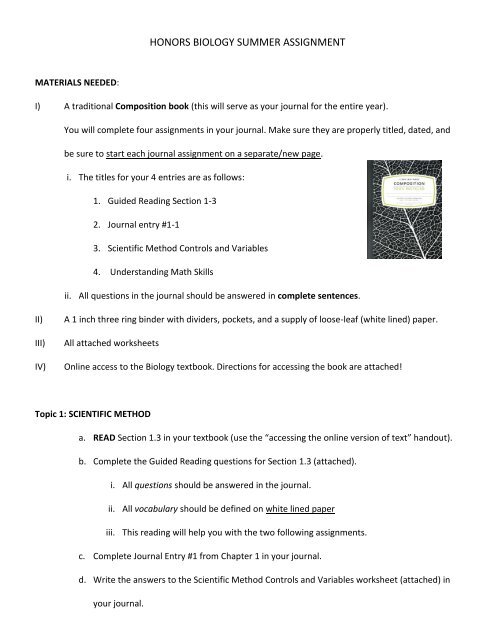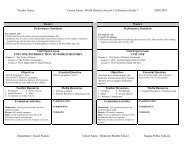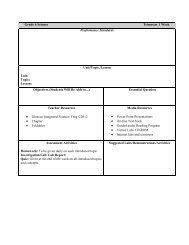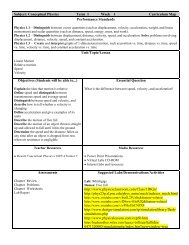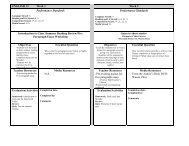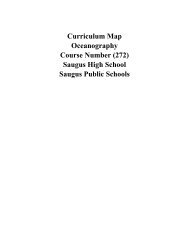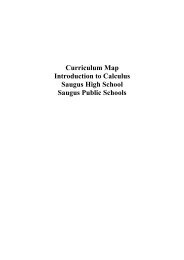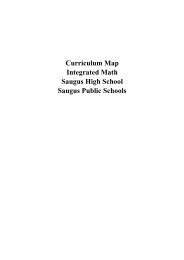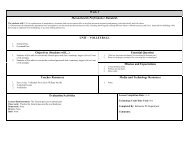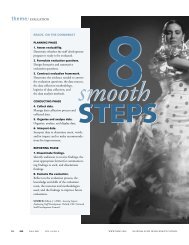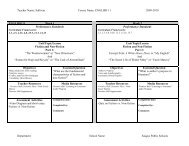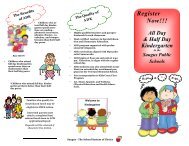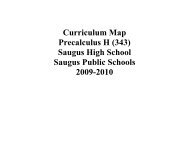honors biology summer assignment - Saugus Public Schools
honors biology summer assignment - Saugus Public Schools
honors biology summer assignment - Saugus Public Schools
Create successful ePaper yourself
Turn your PDF publications into a flip-book with our unique Google optimized e-Paper software.
HONORS BIOLOGY SUMMER ASSIGNMENT<br />
MATERIALS NEEDED:<br />
I) A traditional Composition book (this will serve as your journal for the entire year).<br />
You will complete four <strong>assignment</strong>s in your journal. Make sure they are properly titled, dated, and<br />
be sure to start each journal <strong>assignment</strong> on a separate/new page.<br />
i. The titles for your 4 entries are as follows:<br />
1. Guided Reading Section 1-3<br />
2. Journal entry #1-1<br />
3. Scientific Method Controls and Variables<br />
4. Understanding Math Skills<br />
ii. All questions in the journal should be answered in complete sentences.<br />
II)<br />
III)<br />
IV)<br />
A 1 inch three ring binder with dividers, pockets, and a supply of loose-leaf (white lined) paper.<br />
All attached worksheets<br />
Online access to the Biology textbook. Directions for accessing the book are attached!<br />
Topic 1: SCIENTIFIC METHOD<br />
a. READ Section 1.3 in your textbook (use the “accessing the online version of text” handout).<br />
b. Complete the Guided Reading questions for Section 1.3 (attached).<br />
i. All questions should be answered in the journal.<br />
ii. All vocabulary should be defined on white lined paper<br />
iii. This reading will help you with the two following <strong>assignment</strong>s.<br />
c. Complete Journal Entry #1 from Chapter 1 in your journal.<br />
d. Write the answers to the Scientific Method Controls and Variables worksheet (attached) in<br />
your journal.
Topic 2: WAYS TO REPRESENT AND INTERPRET DATA<br />
a. Read the Understanding Math Skills in your textbook<br />
i. use the “accessing the online version of text” handout to locate the readings<br />
b. Answer the following questions in your journal.<br />
Read the section: Make and Use Tables<br />
1. Describe the components of a table.<br />
2. Answer practice problem #2 at the end of the section.<br />
Read the section: Make and Use Graphs<br />
3. What is a graph?<br />
4. Why are graphs used?<br />
5. What are the three types of graphs used in science?<br />
Read the section: Line graphs<br />
6. What does a line graph show?<br />
7. On a line graphs, where are the independent and dependant variables<br />
plotted?<br />
8. Answer practice problems 3 and 4.<br />
Read the section: Bar graphs<br />
9. What is displayed in a bar graph?<br />
10. Answer practice problem #5.<br />
Read the section: Circle graphs<br />
11. What does a circle graph show?<br />
12. Carefully read the section on circle graphs then answer practice problem #6.<br />
Topic 3: Scientific word origins (use the “accessing the online version of text” handout to locate the terms)<br />
The prefixes and suffixes on this list are important not only to understanding <strong>biology</strong> words but<br />
words outside of <strong>biology</strong> as well, such as on the SAT’s. You should learn the meanings of these word origins<br />
and be prepared to be quizzed on them in the first week of school.
ACCESSING THE ONLINE VERSION OF THE BIOLOGY HONORS TEXTBOOK<br />
Steps:<br />
1. Go to www.<strong>biology</strong>gmh.com<br />
2. In the box in upper left corner: Choose State: MA<br />
Click Student/Parent<br />
Choose Subject: Science<br />
3. Next page: Click on Biology then Glencoe Biology 2009<br />
4. Next page: Under Textbook resources click on StudentWorks Plus Online<br />
5. On left side of next page, click on StudentWorks Plus Online again<br />
6. Then click on it again on middle of screen.<br />
7. Next page: Enter your access code: EAEE8C0300 click Submit and the book should open.<br />
IMP: If this code does not work, email me at khoey@saugus.k12.ma.us<br />
8. For the Scientific Method <strong>assignment</strong>, do the following:<br />
a. Click on the Table of Contents tab at the top left.<br />
b. Click on Student Guide Chapter 1 Section 3: Methods of Science<br />
c. You need to read this section from pages 16-21 then complete the guided reading<br />
questions and vocabulary terms for that section. (on attached worksheet)<br />
9. For the Understanding Math Skills <strong>assignment</strong>, do the following:<br />
a. Click on the Table of Contents tab at the top left.<br />
b. Click on Student Resources Skillbuilder Handbook<br />
c. Under the Math Skills section you are reading the following sections:<br />
i. Making and using tables (pg. 1115)<br />
ii. Making and using graphs (pg. 1115-1116)<br />
iii. Bar graphs and circle graphs (pg. 1117-1118)<br />
d. You need to answer the questions from these sections in your journal. The questions<br />
are on an attached worksheet.<br />
10. For the Scientific Word Origins <strong>assignment</strong>, do the following:<br />
a. Click on the Table of Contents tab at the top left.<br />
b. Click on Student Resources Skillbuilder Handbook Scientific Word Origins
GUIDED READING: Section 1.3<br />
Honors Biology<br />
Directions: As you read Section 1.3 (pgs. 16-21), answer the questions below in complete sentences in your<br />
journal. Label the top of the page as Guided Reading 1.3. When noted (*), define any vocabulary terms on<br />
a separate sheet of paper (white lined). You can refer to the glossary of the book for definitions.<br />
METHODS OF SCIENCE<br />
I) Ask a Question<br />
* Define observation, inference, and scientific method on the vocabulary sheet.<br />
II)<br />
Form a hypothesis<br />
* Define hypothesis and serendipity on the vocabulary sheet.<br />
2. Explain what happens when a hypothesis is supported by data. What happens if a hypothesis is<br />
not supported by data?<br />
III)<br />
Collect the Data<br />
* Define experiment, control group and experimental group on the vocabulary sheet.<br />
* Define independent variable, dependant variable, and constant on the vocabulary sheet.<br />
3. For the kittiwake experiment, write a paragraph identifying the following:<br />
The hypothesis, the control group, the experimental group, the independent variable, and the<br />
dependant variable.<br />
* Define data on the vocabulary sheet.<br />
4. Differentiate between quantitative and qualitative data.<br />
5. What quantitative data was gathered in the kittiwake experiment?<br />
IV)<br />
Analyze Data<br />
6. Explain the relationship between the mass of anole lizards and time as shown in the graph in<br />
Figure 1.17. What do you think will be the mass of the anole at 21 days? Explain your answer.<br />
V) Report Conclusions
Journal Entry: Chapter 1, Entry #1<br />
Controlled experiments<br />
You won’t believe what happened in school today!! I got a D in chemistry. My chemistry<br />
teacher assigned a project to conduct a controlled experiment of our choice. I chose to test<br />
which type of laundry detergent was more effective at removing stains: Tide or Wisk. Here<br />
is a description of my experiment.<br />
I got an old white T-shirt and a pair of jeans. I put a ketchup stain on the T-shirt and<br />
then slid on the lawn to get a grass stain on the jeans. Then, I put one scoopful of powdered<br />
Wisk on the ketchup stained T-shirt and two capfuls of liquid Tide on the grass stained<br />
pants. I threw the jeans in the washing machine in cold water for 10 minutes. Then, I washed<br />
the T-shirt in warm water for 6 minutes (since it’s smaller). Then, I put both the T-shirt and<br />
jeans in the dryer for 10 minutes. When I removed the clothes, the grass stain was lighter<br />
than the ketchup stain so I concluded that Tide was the better detergent.<br />
1. Apparently, my teacher did not like my experiment. He said that it was not<br />
“controlled”. What did I do wrong???<br />
Describe at least 5 mistakes I made in conducting this experiment.<br />
2. Describe, in detail, the controlled experiment you would conduct to properly test the<br />
effectiveness of the two laundry detergents.
Name _________________________________________________ Date ______________ Per _______<br />
SCIENTIFIC METHOD WS: Controls and Variables<br />
Biology<br />
Sponge Bob and his Bikini Bottom pals have been busing doing a little research. Read the description for<br />
each experiment and answer the questions.<br />
1. Patty power<br />
Mr. Krabbs wants to make Bikini Bottom a nicer place to live. He has created<br />
a new sauce that he thinks will reduce the production of body gas associated<br />
with eating crabby patties from the Krusty Krab. He recruits 100 customers with<br />
a history of gas problems. He has 50 of them (Group A) eat the crabby patties<br />
with the new sauce. The other 50 (Group B) eat crabby patties without the<br />
sauce. Two hours after eating the crabby patties, 30 customers in Group A reported having fewer gas<br />
problems and 8 customers in Group B reported having fewer gas problems.<br />
a. Which people are in the control group?<br />
b. What is the independent variable?<br />
c. What is the dependant variable?<br />
d. What should Mr. Krabb’s conclusion be?<br />
2. Slimotosis<br />
Sponge Bob notices his pal Gary is suffering from slimotosis, which occurs<br />
when the shell develops a nasty slime and gives off a horrible odor. His friend<br />
Patrick tells him rubbing seaweed on the shell is the perfect cure. Sandy tells<br />
him that drinking Dr. Kelp will be a better cure. Sponge Bob decides to test the cures by rubbing Gary with<br />
seaweed for 1 week and having him drink Dr. Kelp that same week. After the week of treatments, the slime<br />
is gone and Gary’s shell smells better. Sponge Bob concludes that both treatments work.<br />
a. Is Sponge Bob’s conclusion correct? Explain why or why not.<br />
b. Describe a better way to test Patrick and Sandy’s hypotheses.
3. Marshmallow muscles<br />
Larry was told that a certain muscle cream was the newest best thing on the market and claims to<br />
double a person’s muscle power when used as part of a muscle-building workout. Interested in this<br />
product, he buys the special muscle cream and recruits Patrick and SpongeBob to help him with an<br />
experiment. Larry develops a special marshmallow weight lifting program for Patrick and SpongeBob. He<br />
meets with them once every day for a period of 2 weeks and keeps track of their results. Before each<br />
session, Patrick’s arms and back are lathered in the muscle cream, while SpongeBob’s arms and back are<br />
lathered with the regular lotion.<br />
a. Which person is the control group?<br />
b. What is the independent variable?<br />
c. What is the dependant variable?<br />
d. Examine the data table. What should Larry’s<br />
conclusion be? Explain your answer.<br />
Number of marshmallows lifted<br />
Time Patrick SpongeBob<br />
Initial 18 5<br />
After 1 week 24 9<br />
After 2 weeks 33 17<br />
4. Microwave miracle<br />
Patrick believes that fish that eat food exposed to microwaves will become smarter and would be<br />
able to swim through a maze faster. He decides to perform an experiment by placing fish food in a<br />
microwave for 20 seconds. He has the fish swim through a maze and records the time it takes for each one<br />
to make it to the end. He feeds the special food to 10 fish and gives regular food to 10 others. After 1<br />
week, he has the fish swim through the maze again and records the times for each.<br />
a. What was Patrick’s hypothesis?<br />
b. Which fish are in his control group?<br />
c. What is the independent variable?<br />
d. What is the dependant variable?<br />
e. Examine the data tables. What should<br />
Patrick’s conclusion be?
5. Squidward’s symphony<br />
Squidward loves playing his clarinet and believes it attracts more jellyfish than<br />
any other instrument he has played. In order to test his hypothesis, Squidward<br />
played a song on his clarinet for 5 minutes and counted the number of jellyfish he<br />
saw in his front yard. After the jellyfish left, he played the song again. He played the<br />
song a total of 3 times on his clarinet and repeated the experiment using a flute and<br />
a guitar. He also recorded the number of jellyfish he observed when he was not<br />
playing an instrument. His results are shown in the chart.<br />
a. What is the independent variable?<br />
b. What is the dependant variable?<br />
c. What is (are) the control group(s)?<br />
d. What is (are) the experimental group(s)?<br />
e. What should Squidward’s conclusion be?<br />
Number of Jellyfish/Instrument<br />
Trial No Music Clarinet Flute Guitar<br />
1 5 15 5 12<br />
2 3 10 8 18<br />
3 2 12 9 7<br />
6. Super bubbles<br />
Patrick and Sponge Bob love to blow bubbles! Patrick found some<br />
Super Bubble Soap at the SailMart. The ads claim that Super Bubble<br />
Soap will produce bubbles that are twice as big as bubbles made with<br />
regular bubble soap. Patrick and Sponge Bob made up two samples of<br />
bubble solution. Sample 1 was made with 5 oz. of Super Bubble Soap<br />
and 5 oz. of water. Sample 2 was made with 5 oz. of water and 5 oz. of regular bubble soap. Patrick and<br />
Sponge Bob used their favorite bubble wands to blow 4 different bubbles and did their best to measure the<br />
diameter of each one. The results are shown in the chart.<br />
a. What did the Super Bubble ads claim?<br />
b. What is the independent variable?<br />
c. What is the dependent variable?<br />
d. What should Patrick and Sponge Bob conclude the<br />
claims made by Super Bubble soap?<br />
Bubble Super Bubble<br />
(Sample 1)<br />
Regular Soap<br />
(Sample 2)<br />
1 16 cm 12 cm<br />
2 10 cm 5 cm<br />
3 15 cm 15 cm<br />
4 14 cm 10 cm


